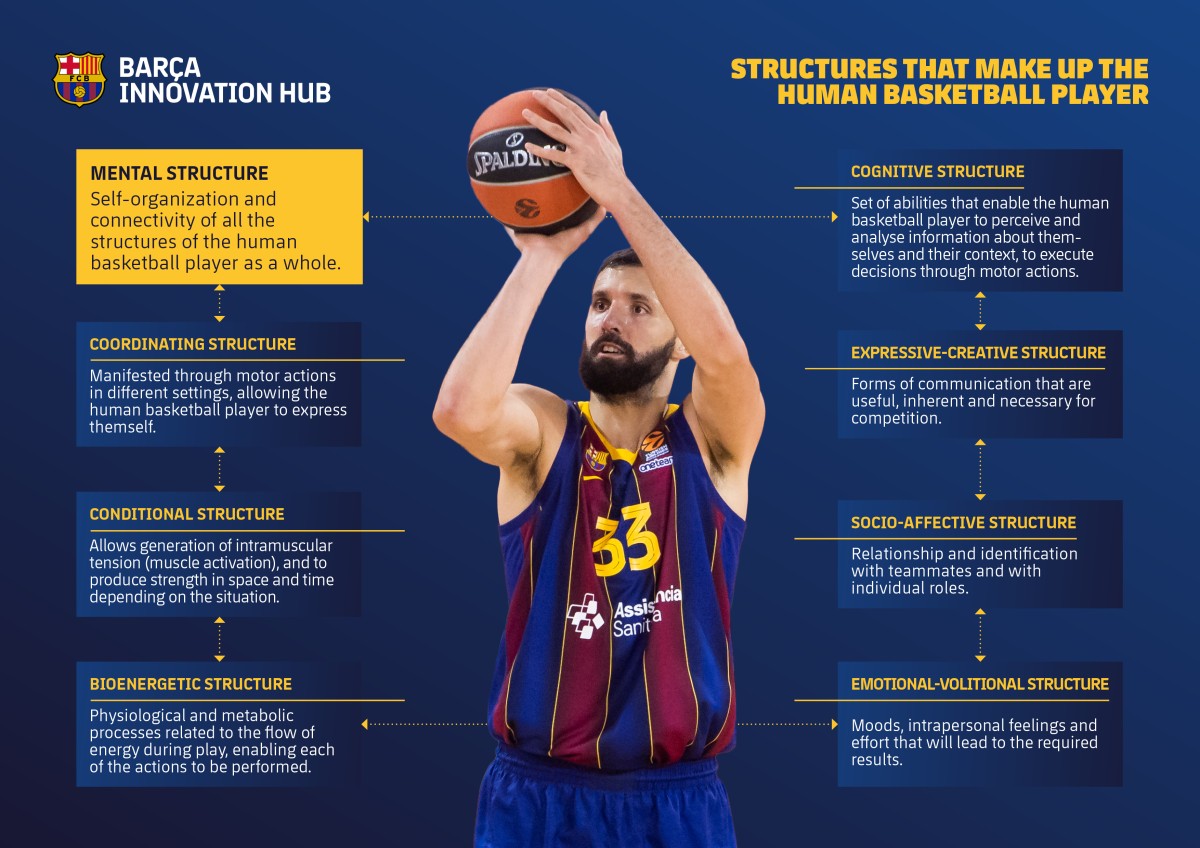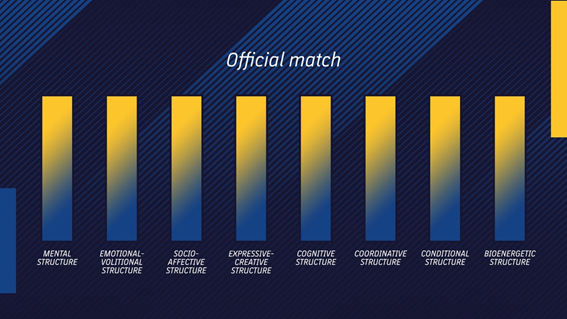Since its creation, the Fútbol Club Barcelona (FCB) Performance Area has developed a work methodology in which the athlete as a human being is the cornerstone to optimise performance in their sport. The human athlete is a hyper-complex, hierarchically-organised organism that interacts dynamically with its environment, self-organising as it advances through the training process. Therefore, due to the specific nature of each sport and athletes’ integrated responses, FC Barcelona’s structured training (ST) methodology is constructed holistically on the basis of complex dynamic systems, placing its training methodology at the epicentre of the human athlete and combining the criteria of specificity, individualisation, variability, and optimization.1
Because a basketball player’s motor and cognitive requirements differ from those of a football or field hockey player, the training continuum must plan for the requirements of each sport, seeking to provide a sequence of stimuli to the human basketball player (HBP) that enable them to evolve in their sports towards achieving whatever objectives are set. From this perspective, structures training is set from two areas: co-adjuvant training and optimization training.3 The former prepares the human basketball player for the training process and allows them to develop the systems and structures specific to each specialty in an at least a partly non-specific environment of the sport.1,2 On the other hand, optimization training aims to optimize the human basketball player’s performance in competition. Therefore, optimization training must be done in the setting of the sport itself and using specific elements thereof.
Based on this proposal (for each sports section at Barça), co-adjuvant training is divided according to its generic and general orientation, while optimization training is divided into directed, special and competitive orientations (Figure 1):

This article presents a methodological proposal devised for the FC Barcelona basketball section. The organisation of co-adjuvant training involves three levels that serve as a sequencing model towards the inherent specificity of the sport, with level 0 being the least specific.4 For example Level 0- (non-oriented) includes any activity with very low (or no) similarity to competition (Videos 1-2), Level 0+ oriented encompasses all physical activity with little similarity to competition (Videos 3 and 4) and finally Level 1 includes physical activity with certain correspondence to what would be expected in competition (Videos 5 and 6).
Videos 1 and 2. Example of work in Level 0- (non-oriented) and classification by involvement of HBP structures.
Videos 3 and 4. Example of work in Level 0+ (oriented) and classification by involvement of HBP structures.
Videos 5 and 6. Example of work in Level 1 and classification by involvement of HBP structures.
In relation to optimization training, as with co-adjuvant training, the levels encompass tasks based on their specificity and complexity (Figure 1). Hence, the higher the level, the greater the similarity to competition. For example Level 2 would encompass preferential simulation situations (PSS) or tasks that occur in basketball without opposition or with passive opposition (1-on-0 or 2-on-0) (Videos 7 and 8) while Level 6 includes PSSs that involve the participation of 8 to 10 players executing 4-on-4, 5-on-4 or 5-on-5 PSSs (video 9). Finally, Level 10 would be a competitive basketball game (Video 10).
Videos 7 y 8. Example of work in Level 2 and classification by involvement of HBP structures.
Videos 9. Example of work in Level 6 and classification by involvement of HBP structures
Videos 10. Example of a competitive game (level 10) and classification by involvement of HBP structures.
A relevant aspect of this methodological concept proposed by the members of the Basketball section based on the proposals of Professor Seirul·lo and the Performance Area, is the use of HBP structures in the design of training tasks. These structures are constituted by different systems that are in constant interaction with the environment which allows the emergence of actions taking place.1 In summary, the structures that determine the performance of basketball players (and of team sports in general) are (Figure 2):

The training process must consider all the systems that make up the structures of a human basketball player since, in addition to the specificity of the task posed at each level, the complexity of the actions will vary depending on the dynamic interaction between the set of structures and systems. Although two tasks may be at the same level, modulation of the ‘load’ on the structures, for example by increasing or decreasing the involvement of coordinative or emotional-volitional elements, causes a totally different kind of adaptation of HBP’s systemic self-organisation. As shown in videos 5 and 6, even though these are two tasks that are included in Level 0 (very little similarity to competition), the impact on the player’s structures is very different. Changing the place where tasks are executed (basketball court or football field), the relationship with team-mates or the chosen implement (football or fitball) will completely determine the player’s responses. Each PSS can be presented as a set of structures and viewed in the format of an equaliser (Figure 3), allowing coaches to quickly assess the nature of the proposed exercise. This methodological proposal allows to holistically integrate the preparation of the HBP basketball based on the theory of complex dynamical systems. Learning processes are optimised when PSSs take into account the way that the HBP regulates and adapts to the different game encounters proposed by the tasks.

This means that coaches and fitness trainers have a methodological proposal based on the HBP and their different biological structures, to programme tasks taking into account the specificity of sport and the differentiated response of each player. The complexity of basketball requires a training approach based on the HBP as a hypercomplex structure and its interaction with the specific basketball environment.
Jairo Vázquez – FC Barcelona Sports Performance Area
References:
- Tarragó, J. R., Seirul-lo, F. & Cos, F. Training in team sports: structured training in the FCB. Apunt. Educ. Física i Esports 103–114 (2019).
- Vargas, F. S. Entrenamiento coadyuvante. Apunt. Med. l’esport 23, 39–42 (1986).
- Moras, G. La preparación integral en el voleibol: 1000 ejercicios y juegos. (Paidotribo, 2000).
KNOW MORE
CATEGORY: MARKETING, COMMUNICATION AND MANAGEMENT
This model looks to the future with the requirements and demands of a new era of stadiums, directed toward improving and fulfilling the experiences of fans and spectators, remembering “feeling” and “passion” when designing their business model.
CATEGORY: FOOTBALL SPORTS PERFORMANCE
Through the use of computer vision we can identify some shortcomings in the body orientation of players in different game situations.
CATEGORY: MEDICINE HEALTH AND WELLNESS
A health check must detect situations which, despite not showing obvious symptoms, may endanger athletes subject to the highest demands.
CATEGORY: FOOTBALL TEAM SPORTS
In the words of Johan Cruyff, “Players, in reality, have the ball for 3 minutes, on average. So, the most important thing is: what do you do during those 87 minutes when you do not have the ball? That is what determines whether you’re a good player or not.”
CATEGORY: MEDICINE HEALTH AND WELLNESS SPORTS PERFORMANCE
Muscle injuries account for more than 30% of all injuries in sports like soccer. Their significance is therefore enormous in terms of training sessions and lost game time.
DO YOU WANT TO KNOW MORE?
- SUBSCRIBE
- CONTACT
- APPLY
KEEP UP TO DATE WITH OUR NEWS
Do you have any questions about Barça Universitas?
- Startup
- Research Center
- Corporate